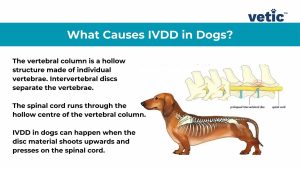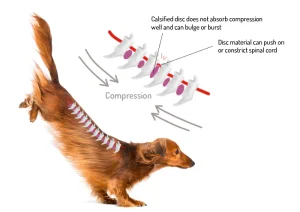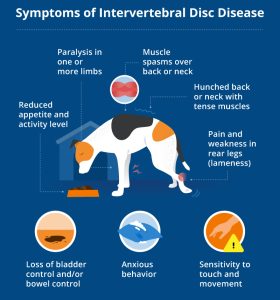Chondrodystrophy (CDDY)
Intervertebral disc disease (IVDD)
Chondrodystrophy (CDDY) is a common body shape in many breeds and is characterized by relatively shortened legs compared to body length. It is thought to be a gene mutation that contributes to IVDD in dachshunds.
What causes IVDD in dachsunds?
Intervertebral discs connect vertebrae, allow spine movement and protect the spinal cord. The intervertebral disc is composed of an outer fibrous layer (annulus fibrosus) and an inner gel- like layer called the nucleus pulposus. In chondrodystrophic breeds, premature hardening of the soft center of the disc at an early age (from birth to one year of age) results in intervertebral disc degeneration (IVDD). This disc degeneration can lead to Type I IVDD which is characterized by rupture of the center of the disc through tears in the outer fibrous layer. Clinical signs result from the pressure applied to the spinal cord and nerves. IVDD in dachsunds is the most serious issue with the dachshund breed.
Clinical signs of IVDD in dachshunds:
Signs of CDDY are recognized in puppies as it affects their body shape.
Type I IVDD in dachshunds is usually first recognized in young adult dogs, with breed-specific differences in age of onset.
Sudden or gradual onset of hind leg weakness (partial paralysis)
Knuckling (paw dragging)
Ataxia (loss of coordination)
Signs of neck or back pain (e.g., reluctance to jump or walk or to be pet or lifted; vocalization when moving; unusual aggression towards being touched; stiff neck or arched back)
Paralysis
Diagnosis of IVDD in dachshunds
Clinical signs
Physical examination
Radiographs may show disc calcification and/or a decreased intervertebral disc space (indicating disc extrusion).
Advanced imaging such as CT or MRI may show additional details.
Early intervention of IVDD in dachshunds provides the best outcome.
Milder cases may be treated with rest and pain medications.
More severe cases may warrant surgical intervention.
Maintain an ideal body condition (weight).
Modify activities to put less stress on the spine such as providing steps or ramps to reduce jumping on and off objects.
Low-stress options such as front clip options may be recommended when a harness is used.
Supplementation with omega fatty acids and/or glucosamine and chondroitin may offer some benefits, although no specific clinical trials have been performed.
Back scoring for IVDD in dachshunds is a veterinary procedure used to assess the risk of Intervertebral Disc Disease (IVDD) in Dachshunds. It involves X-raying the dog’s spine to identify calcifications in the intervertebral discs, which are a sign of potential disc degeneration and increased risk of IVDD. The X-rays are then scored based on the number and location of these calcifications, with higher scores indicating a greater risk.
Here’s a more detailed explanation:
Why is back scoring done?
Dachshunds are predisposed to IVDD, with an estimated 1 in 4 experiencing some form of back problem during their lifetime. Back scoring helps identify dogs at higher risk for IVDD before they show clinical signs, allowing breeders to make informed decisions about breeding and potentially reducing the incidence of the disease.
How is back scoring done?
A veterinarian will take X-rays of the Dachshund’s spine, typically when the dog is between 2 and 4 years old. The X-rays are then sent to a specialist who scores the number and location of calcified discs, assigning a grade from 0 to 3, with 0 being the best and 3 indicating the highest risk.
What do the scores mean?
Grade 0: No calcifications found.
Grade 1: 1-2 calcifications.
Grade 2: 3-4 calcifications.
Grade 3: 5 or more calcifications.
What happens after back scoring?
Breeders can use the back scoring information to make breeding decisions, aiming to reduce the risk of passing on the predisposition to IVDD. It’s important to note that back scoring is a breeder’s tool, and it’s not a guarantee that a dog with a low score will never develop IVDD, or that a dog with a high score will definitely develop it.
Can back scoring be done on any Dachshund?
While back scoring is typically done on Dachshunds between 2 and 4 years old, it can be done on older dogs as well. However, the results may not be as predictive of future IVDD risk as they are in younger dogs.
What if a Dachshund shows signs of IVDD?
If a Dachshund shows signs of IVDD (limping, paralysis, pain, etc.), it should be taken to a veterinarian immediately for diagnosis and treatment.
Genetics:
The Fibroblast growth factor 4 (FGF4) retrogene insertion on chromosome 12 may be responsible for a portion of cases of chondrodystrophy and increased risk for Type I IVDD in certain dog populations.
Dogs with one copy of this variant have modestly shortened legs, while dogs with two copies are more likely to have the characteristically short legs with a relatively long body. CDDY can be caused by other variants alone or in combination with this FGF4 retrogene.
The FGF4 retrogene also increases the risk of IVDD in dachshunds in a dominant fashion. This means dogs with one or two copies of this variant are at an increased risk of developing this disease. While this variant is known to increase the risk of Type I IVDD, it does not explain all cases. There are other factors that contribute to the overall risk of developing Type I IVDD, including other (unknown) genetic variants, lifestyle and other environmental factors.
It is important to understand the frequency of this variant within certain populations is very high, because certain breed standards call for a chondrodystrophic (short legs, long body) appearance. When deciding whether or not to breed a dog with this variant, we recommend considering the whole dog (rather than this one test in isolation).
Other factors to consider include:
Have any relatives of this dog shown back, neck, or neurologic problems?
Does this dog meet the breed standard?
Has this dog passed its breed-required health testing?
Does this dog have the desired temperament for the breed?
Is this dog otherwise healthy?
If all other health and temperament parameters are desired, then breeding dogs with one or two copies of the variant to dogs with no copies is a first step towards reducing the high frequency of this variant within certain breeds. Among breeds in which the frequency of this variant is high, dogs with one or two copies of this variant should not be immediately removed from the breeding population. This practice can reduce the size of the breeding population substantially, leading to other health issues associated with inbreeding and reduced genetic diversity.
At AZ Doxies, we have 1 sire and 1 dame that carry for only 1 copy of CDDY. We had a litter from them and got a puppy who is CDDY clear. We are learning more every day about CDDY and how it affects the dachshund structure. This is why DNA testing for your dachshund is so important.
If you have questions regarding IVDD in miniature dachshunds please give us a call at 352-339-3877 or message us on our instagram @az_doxies
AZ Doxies is dedicated to breeding healthy, happy dachshund puppies. Puppy delivery inside of Florida.
You can learn about our friend Crusoe and his experience with IVDD here. https://celebritydachshund.com/pages/intervertebral-disc-disease-ivdd-in-dachshunds
Learn more about how AZ Doxies does testing for things like IVDD in dachshunds here. https://azdoxies.com/optimal-selection-dna-testing/
AZ Doxies is a breeder of minature dachshunds located in Crystal River, FL. Our dachshund puppies are all DNA tested as well as health tested. We service all of Florida and provide dachshund puppies to approved homes. We are quite picky with the homes we release a puppy to. Our focus is the well-being of the puppy.
There are many breeders to choose from in Florida. We are a different than most dachshund breeders in Florida. AZ Doxies breed our doxies using dachshund standard and dachshund confirmation is paramount as well as favorable DNA and health traits. Having healthy, well adjusted dachshunds is our top priority. We offer minature dachshunds with different colors and patterns. Longhair and smooth coat doxies are available. However, we consider ourselves a small breeder. All of our dogs are inside of our home. We do not breed to get rich but for the love of the breed. We love to see joy on a young couple or childs face when they get a new doxie puppy.
Our goal is to continue to learn and to make sure we are breeding the healthiest dogs available. No more IVDD in dachshunds would be awesome.

Our focus is on combatting IVDD in dachshunds through genetics as well as exercise therapy, and holistic medicine treatment. CDDY is the genetic mutation that increases a dachshund’s suceptabity of having IVDD. We want to stop IVDD before it can start. We need to keep those discs in the spine nice and maluable. The discs should be the texture of foam. Figure eight movements are one example of physical exercise to strengthen your dachshunds back. After a dachshund is two years old, you can have their back scored. Back scoring measures the levels of calcification in the vertebral discs.


